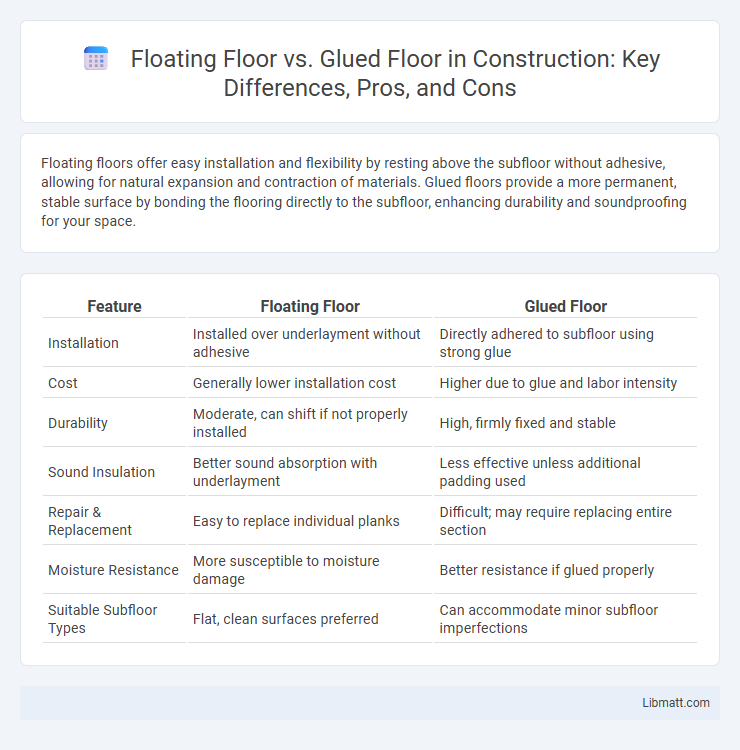Floating floors offer easy installation and flexibility by resting above the subfloor without adhesive, allowing for natural expansion and contraction of materials. Glued floors provide a more permanent, stable surface by bonding the flooring directly to the subfloor, enhancing durability and soundproofing for your space.
Table of Comparison
| Feature | Floating Floor | Glued Floor |
|---|---|---|
| Installation | Installed over underlayment without adhesive | Directly adhered to subfloor using strong glue |
| Cost | Generally lower installation cost | Higher due to glue and labor intensity |
| Durability | Moderate, can shift if not properly installed | High, firmly fixed and stable |
| Sound Insulation | Better sound absorption with underlayment | Less effective unless additional padding used |
| Repair & Replacement | Easy to replace individual planks | Difficult; may require replacing entire section |
| Moisture Resistance | More susceptible to moisture damage | Better resistance if glued properly |
| Suitable Subfloor Types | Flat, clean surfaces preferred | Can accommodate minor subfloor imperfections |
Introduction to Floating and Glued Floors
Floating floors consist of interlocking planks that rest over an underlayment without being attached to the subfloor, providing easy installation and natural expansion. Glued floors require adhesive to bond the flooring directly to the subfloor, offering enhanced stability and soundproofing. Both methods impact installation time, durability, and moisture resistance depending on the specific materials used.
What is a Floating Floor?
A floating floor refers to a type of flooring installation where the planks or tiles are not nailed or glued to the subfloor but instead interlock and rest on an underlayment. This method offers easier installation, increased comfort, and better noise reduction compared to glued floors. You can quickly replace or repair sections without damaging the subfloor, making it a popular choice for DIY projects and renovation.
What is a Glued Floor?
A glued floor refers to flooring that is directly adhered to the subfloor using specialized adhesives, creating a stable and permanent bond ideal for hardwood, vinyl, or engineered wood materials. This installation method reduces movement and squeaking, offering enhanced durability and a smooth surface finish compared to floating floors. Glued floors are commonly preferred in high-traffic areas due to their strong attachment and increased resistance to moisture and temperature changes.
Installation Process: Floating vs Glued
Floating floor installation involves laying planks over an underlayment without adhesive, allowing for easier and faster setup with the ability to expand and contract. Glued floors require applying adhesive directly to the subfloor before placing the planks, ensuring a more permanent bond and increased stability. The floating method is generally less messy and reversible, while glued floors offer superior durability and sound insulation.
Cost Comparison: Floating vs Glued Flooring
Floating floors typically offer a lower initial cost due to easier installation and reduced labor expenses compared to glued floors, which require professional adhesive application. Maintenance costs for floating floors can be higher if planks shift or buckle, whereas glued floors provide a more stable and durable surface, minimizing repair expenses over time. The total cost comparison favors floating floors for budget-conscious projects, while glued floors represent a long-term investment with greater stability and longevity.
Durability and Longevity
Floating floors offer moderate durability due to their installation method, which allows for natural expansion and contraction, reducing the risk of buckling but making them susceptible to moisture damage over time. Glued floors provide superior longevity by securing each plank directly to the subfloor, minimizing movement and increasing stability, which enhances resistance to wear and tear in high-traffic areas. Choosing between floating and glued floors depends on the specific environment and usage, with glued floors generally favored for long-term durability.
Maintenance and Repair Considerations
Floating floors offer easier maintenance and repair due to their modular design, allowing individual planks to be replaced without disturbing the entire floor. Glued floors provide a more stable surface but complicate repairs, as removing damaged sections often requires professional intervention and can damage adjacent areas. Regular cleaning is essential for both, but glued floors demand more caution to prevent adhesive breakdown and lifting.
Acoustic and Comfort Differences
Floating floors reduce sound transmission and provide better acoustic insulation due to the air gap and underlayment layer, enhancing your room's quietness. Glued floors offer firmer footing and less bounce, resulting in a more stable and solid feel underfoot but often transmit more impact noise. Choosing a floating floor improves comfort and sound absorption, while glued floors deliver durability with less cushioning effect.
Best Applications for Each Flooring Type
Floating floors are ideal for areas with fluctuating humidity and temperature, such as basements and living rooms, because they allow natural expansion and contraction without damage. Glued floors provide a more permanent installation, best suited for high-traffic spaces like kitchens and commercial areas where durability and stability are essential. Your choice depends on the specific environmental conditions and usage demands of the room.
Which Flooring Option is Right for You?
Choosing between a floating floor and a glued floor depends on your home's moisture levels, installation skill, and budget. Floating floors offer easier installation, flexibility with subfloors, and can be more cost-effective, making them ideal for DIY projects or areas with slight moisture variations. Glued floors provide enhanced stability and sound insulation, suitable for high-traffic zones or spaces requiring a solid, permanent bond, but typically demand professional installation.
Floating floor vs glued floor Infographic

 libmatt.com
libmatt.com